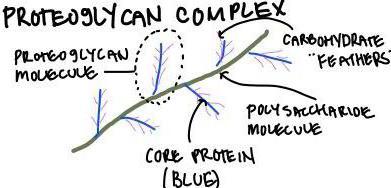What are Proteoglycans?
 Niki Foster
Niki Foster
Proteoglycans are a type of molecule found in the connective tissue of the body. Connective tissue is fibrous tissue that provides support for other body structures. Proteoglycans make up a major part of the extracellular matrix, the material between cells that provides structural support. Unlike in other body tissues, the extracellular matrix is the most important part of connective tissue.
Proteoglycans are heavily glycosylated glycoproteins. This means that they are proteins with chains of polysaccharides, a kind of carbohydrate, attached. The specific type of polysaccharides attached to proteoglycans are called glycosaminoglycans (GAGs). Proteoglycans are negatively charged because of the presence of sulfates and uronic acids. The GAG chains of a proteoglycan may be made of chondroitin sulfate, dermatan sulfate, heparin sulfate, heparan sulfate, or keratan sulfate.

In addition to the type of GAG they carry, proteoglycans can be categorized by size. Large molecules include aggrecan, an important component of cartilage, and versican, which is found in the blood vessels and skin. Small molecules present in various connective tissues include decorin, biglycan, fibromodulin, and lumican. Because they are negatively charged, proteoglycans also help to attract positive ions, or cations, such as calcium, potassium, and sodium. they also bind water, and aid in the transport of water and other molecules through the extracellular matrix.
All components of a proteoglycan are synthesized within cells. The protein portion is synthesized by ribosomes, which make proteins out of amino acids. The protein is then moved to the rough endoplasmic reticulum (RER). It is glycosylated in the Golgi apparatus, another organelle, in a number of steps.
First, a link tetrasaccharide on which the polysaccharides can grow is attached to the protein. Then, the sugars are added one by one. When the proteoglycan is complete, it leaves the cell through secretory vesicles, and enters the extracellular matrix.
A group of genetic metabolic disorders known as mucopolysaccharidoses are characterized by the inability to break down proteoglycans due to absent or malfunctioning lysosomal enzymes. These disorders lead to a proteoglycan buildup in the cells. Depending upon the type of proteoglycan allowed to build up, mucopolysaccharidoses can cause symptoms ranging from short stature and hyperactivity to abnormal skeletal growth and mental retardation.
AS FEATURED ON:
AS FEATURED ON:











Discussion Comments
@nony - Yes, the function of cartilage includes both support and increased mobility.
It’s strange, actually; while doctors understand and acknowledge the role of Glucosamine in cartilage and joints, they don’t usually believe that the supplements can do much help. Supposedly the only evidence that exists is anecdotal and they say there are no double blind studies that prove it works.
I can’t make sense out of these contradictions, only to say that, like you, it should work at least in theory. The only thing I would wonder about is whether you need a supplement or would it be best to try to get that nutrient from natural foods alone.
A friend of mine keeps pushing glucosamine as a miracle supplement for strong joints and cartilage.
He swears that it helped him with arthritis and joint mobility. I haven’t tried it myself, because I’ve heard that the science is a bit shaky, but one of the things that he mentioned was the importance of proteoglycans in cartilage.
I kind of tuned out the medical explanation but I did recall that he said they were important for strong cartilage. It seems to make sense, since the article mentions that proteoglycans are needed for strong support in connective tissue.
At least at first glance, there seems to be a scientific basis for the benefits of glucosamine. I guess I should probably give it a try.
Thank you for a straightforward explanation. Useful information for the neophyte and out of date scientist.
Thank you, for explaining proteoglycans. This article is important to the relation of our joints for anabolic building to sustain optimum health.
Cheers!
Post your comments